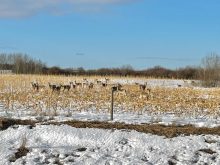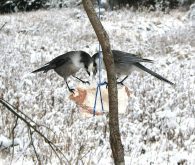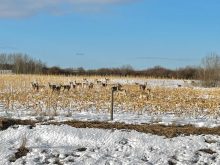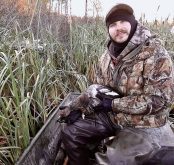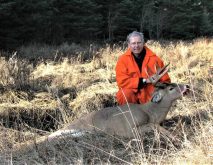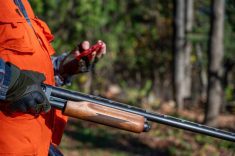Bagging the deer or bird is one thing; preparing and serving wild game for the table always the second part of my hunting adventures.
In terms of time spent, most hunters only get in a few days of actual hunting a year. Cooking that game though, is an activity that can run all year long.
Looking back to my youth, my mother seemed to hold a general view that wild meat was a little suspect and the best response was heat, and lots of it. Everything was cooked well done, which usually brings out the worst in most wild meat. It becomes dry, gamey and tougher. Braising meats are the exception, which I’ll touch on later.
Read Also

Manitoba Ag Days 2026: Local businesses gear up for Brandon farm show
Most of agriculture is seemingly at Manitoba Ag Days each January: Manitoba agribusinesses and farm groups look forward to connecting with farmers at the 2026 show.
Mom was a great cook, but I’m sorry to say that she got it mostly wrong with wild game.
Wild game fundamentals
I wear the chef’s hat in our house when it comes to wild game. That became a bit of a trial by fire as my kids grew and took more notice of what I was serving. They watched the Food Network and expected a parade of new recipes.
That push, and my own curiosity, helped drive me up the learning curve. Nowadays, l will often serve wild game to non-hunting guests, and many are pleasantly surprised by the results.
Good recipes are important, but it really starts with understanding the inherent properties of what you’re preparing. Cooking a grouse or a duck like you would a chicken isn’t a good plan and expecting wild game to taste like domestic animals usually leads to disappointment. Wild critters have their own flavours. Not better or worse; just different.

Let’s start with two basic rules: First, use cooking methods best suited to the game you are preparing. You wouldn’t use a single cooking method for every cut of beef. The same is true for venison or a goose.
Second, don’t be like my mother. Most game should not be cooked to well done, unless you are preparing braising cuts or are cooking fresh sausages or ground meat. Wild game is very lean and, if there is fat, it isn’t marbled into the meat.
Bird flu’s rapid expansion and alarming incidents of transmission to humans brings up an additional and critical consideration that has made me rethink my recipes. For my part, I normally cook wildfowl to medium rare, medium at most, but health authorities do recommend cooking birds to an internal temperature of 165 F before serving. That way, potential pathogens are dealt with.
Upland game birds
A good result on the table starts during the hunt.
In the field, cool down your birds as soon as possible after taking them. Keep them out of the sun and think about using a large cooler with some ice, especially on warmer days. With this approach, waiting until the end of the day to clean them should be fine.
Grouse skin is thin, so plucking can be a challenge. Instead, I peel back the skin to take the breasts and legs. At cooking time, I cut the breast meat into relatively thick strips, separate the thigh from the drumstick and then season and quickly sauté the whole works before serving in a white sauce.
There isn’t a lick of fat on upland birds, so they are especially sensitive to overcooking. Too much heat dries it out and makes it tougher.
Duck options
One of the first considerations in the field is whether to pluck or skin a bird. Skinning is much easier, but you lose important attributes and some cooking options. A plucked bird can be roasted whole, or fillets can be carved off with the breast and legs held together by the skin.
Intact skin retains all the fat under it, and that makes for a juicier result. I will often save a few of the fattest, late-season birds for oven roasting, but most of my spoils are filleted for the barbecue. Smokey flavours and marinades add some magic to the final product.
My birds are brined after I pluck and singe them. This draws out blood and reduces the stronger flavours. I use three-quarters of a cup of pickling salt per four liters of water, soak them overnight in the fridge and give them a good wash after.

My most-used recipe starts with a marinade of soy sauce, apple juice, crushed garlic, ginger, lime juice and chili sauce. After four to six, the fillets hit the charcoal barbeque, made more smokey with some apple wood.
As with grouse, don’t overcook! Again, guidance for avoiding harmful pathogens like bird flu includes cooking to an internal temperature of 165 F. Go no higher than you need to.
The small duck legs are a bit of work to eat, but they are the juiciest, tastiest part. I will shamelessly filch them from other’s plates when they’ve been left uneaten.
When I do roast a whole duck, I rub in some Montreal steak spice before searing in a frying pan. I then place them in a 325 F oven for slow, even cooking. Here again, cook to an internal temperature of 165 F.
I use the drippings to make gravy before serving.
If you have skinned your birds, barbecuing or sautéing the breasts in a frying pan will work. Skinned breasts will overcook and dry out more easily, so be extra careful. Think about adding gravy or a sauce when you serve it.

Goose challenges and opportunities
In addition to being much bigger than ducks, some of your geese could be more than a decade old, so there is more to think about here.
As with ducks, I usually pluck geese, which is more work than skinning, but I have gotten it down to about five to 10 minutes per bird. When I take skin-on breast fillets, I try to separate them by age. The tail feathers of young birds are relatively short and are frayed at the ends, while adult birds have longer, well-formed tail feathers. I keep the legs separate because they need different cooking methods. As with ducks, I brine my geese.
Many goose hunters consign all their goose meat for jerky or sausage and, unfortunately, some will leave the legs behind after cleaning. I think these approaches miss out on some great meals.

Breasts from young geese can be marinated, barbecued to an internal temperature of 165 F and eaten like steak. It’s remarkably like red meat. Breasts from older birds can be ground up with bacon (three parts goose to one part bacon) to make a tasty burger. Sausage and jerky are also options. I also have a recipe for corned goose that, sliced, makes a nice sandwich meat.
Goose legs can be tough as nails when roasted or barbecued but, when braised to tenderness, they are transformed into some of the best, most versatile meat in my larder. After a couple of hours of simmering, the mild-flavoured meat can be pulled away from the bone and used in soups, stews, curries or stroganoff. A family favourite is a “pulled goose” recipe that can leave my guests thinking that they just ate pulled pork.
I now process goose legs in my pressure canner, like Grandma might have done with chickens in the days before refrigeration. The meat’s tender, ready for any number of recipes and is stored on the shelf instead of taking up space in my freezer.
Deer for dinner
Many hunters process their deer meat into burger, sausage and perhaps jerky. It’s good that they are making full use of the animal, but I think it’s also a missed opportunity.
Doing your own butchering helps to unlock more options because you get the cuts and proportions that you want. While I learned from friends and books, there are excellent how-to videos online these days.
I begin by taking off the tenderloin and the backstraps (long loin). Then I remove the hip and separate the muscle bundles into mini versions of beef roasts – sirloin tip, round, eye of round, rump and shank. I used to cut across these bundles to make my roasts, but I much prefer the roasts I now get from the extra bit of work.
There’s a great YouTube video I suggest you check out: “How to Butcher a Deer Hind Quarter * EVERY CUT EXPLAINED *”
I take blade and chuck roasts, bone-in, off the shoulder for use in braising recipes. Everything else goes for burger and sausage.
Deer fat has a high melting point and, frankly, tastes awful. Trim it aggressively, including the meat going into the burger/sausage pile.
My long loin and hind quarter cuts are left as small roasts and are mostly grilled. Most deer roasts will only be about six to eight centimetres thick, so you can cook them like you would a thick steak.
I like a simple approach for grilling venison. I use a dry rub with salt, pepper, chili and cumin, and barbecue to medium-rare. With gas, I start with a hot grill to get a good sear and grill marks, but drop it quickly (below 400 F) to get more even cooking to the desired temperature. For me, that’s about 130 F. After resting for 10 minutes, it should be served right away.
If you love pot roast, use the cuts that are best suited for braising. All the connective tissue in blade, chuck and rear shank cuts break down during braising, producing a tender and juicy finished product. If you use hind quarter roasts like the sirloin tip or round, there is less collagen and these cuts don’t turn out as well, even when bathed in gravy.
A saucy addition
Two basic tastes enhance grilled venison and waterfowl: salt and sweet.
Salt can be infused with a soy sauce-based marinade, or by using a dry rub with salt. I often introduce sweetness with a savoury fruit sauce made from blueberries, diced onion, meat stock, butter, wine, sage and a dash of maple syrup. Saskatoons also work well.
Gas or charcoal?
In a bid to up my game, my kids bought me a charcoal kettle barbecue a few years ago. After a couple of false starts, I could see that it’s a game changer compared to gas. It’s easier to cook at lower temperatures, which makes for more even cooking. I add wood for extra smokiness and I don’t get flare-ups when I cook fattier waterfowl. I assume that pellet barbecues would work just as well.
Adventures in wild game eating
Many hunters are content to stick with tried-and-true approaches and, if they make full use of the animals they take, why not? But if you feel like there’s more to be had from your wild game, start with an open mind and an understanding of its inherent properties. Either way, bon appetit!
Recipes for wild game

Grouse in white sauce
This dish works especially well served on a bed of broad noodles and goes well with white wine or pale ale.
Ingredients
- Breast, thighs and legs from two ruffed or sharp-tailed grouse, or three Hungarian partridge (cut breasts cut into centimetre-wide strips and separate thighs from drumsticks)
- ½ cup of flour, seasoned with salt and pepperoil or butter
White sauce
- 3 tbsp butter
- 1.5 tbsp flour
- 2 cups of whole milk (10 per cent will make it creamier)
- Two cloves garlic, minced½ tsp nutmeg
- Salt and pepper to taste
- 1/3 cup sundried tomatoes (optional)
Directions
Sauce: Heat the butter and add the garlic in a small saucepan. Cook lightly before adding flour. Stir the mix over low heat for a minute or two to cook, but not burn, the flour.
Add milk and, while bringing the mixture to a simmer, whisk constantly to keep from burning or separating. After a few minutes, add nutmeg, salt, pepper and sundried tomatoes. Simmer this mix gently for a few more minutes, then set aside, away from heat. The sauce should be a little on the thin side, rather than too thick.
Meat: Season the meat pieces and sear in a skillet over a high heat with a good amount of oil or butter. Brown the pieces, but don’t cook past rare. The legs will take a bit more time to cook.
Pour the white sauce in with the meat, bring back to a simmer and cook until done. Take it off the heat and serve right away.
Barbecued duck fillet
Barbecued duck goes very well with wild rice and a savoury blueberry sauce. I enjoy this meal with a local IPA beer, while my wife prefers a robust, dry red wine.
Ingredients
- Four duck fillets from a medium or large ducks
Marinade
- ½ cup apple juice
- ½ cup soy sauce
- 1 inch of ginger, grated
- 2 tbsp chili garlic sauce (or 2 tbsp chili sauce and three mashed garlic cloves)
- 3 tbsp lime juice
Directions
Mix the marinade ingredients in a large ziploc bag and drop in the duck fillets, taking care to push the air out while closing. Marinade for four to six hours in the fridge.
Place the marinaded duck fillets skin side down and barbecue for four to six minutes. If you are using propane, keep the temperature at 400 F or lower and watch out for flaming, especially if your birds have some fat. Finish off on the flesh side when the meat is cooked about two-thirds of the way through. Take off the barbecue when the internal temperature reaches 165 F (as per recommendations for avoiding bird flu) rest for a few minutes before serving.
On a charcoal barbecue (my preferred method), place some wood pieces with the hot coals (I prefer apple wood) and start at 350 F, which then calls for a slightly longer cooking time but a more even, smokey result.

Savoury blueberry sauce for waterfowl and venison
Ingredients
- 1 cup blueberries
- ¼ cup onion, finely chopped
- 1 cup meat stock
- 1/2 cup red wine
- 2 tbsp maple syrup (or honey)
- 3 tbsp butter
- ½ tsp sagebutter
- Salt and pepper to taste
Directions
In a saucepan, cook onions in one tablespoon of butter until soft. Add stock, wine and berries and simmer to reduce liquid by half. Add the remaining butter, maple syrup, sage, salt and pepper and simmer for a few more minutes.
Simple barbecued venison
Ingredients
- A roast cut from the long loin, or a round roast off the hind quarter
- Dry rub of your choice that’s salty and has some heat
Directions
Coat the meat with your favourite dry rub about 15 minutes before cooking. Mine has salt, pepper, chili powder, garlic powder and smoked paprika.
Gas barbecue: Take the temperature up to about 400 F, enough to heat the grill sufficiently to get a good sear. Place the meat on the grill, cover and lower the heat to keep the temperature at 400 F or lower (if you want “diamond” grill marks, turn the meat 90 degrees after about five minutes). After 10 or 12 minutes (depending on thickness), turn the meat over and cook covered for another 10-12 minutes, checking the internal temperature after a few minutes. I take venison off at 130 F and rest it a few minutes before serving.
Charcoal barbecue (my preferred approach): Add wood chunks to the coals to get more smoke. Cook at a somewhat lower heat (350 F), and follow the instructions above, knowing that the cooking time will be longer.
Serve the venison with a savory fruit sauce if you have some made up. Venison goes well with a robust red wine or a well-hopped beer.




